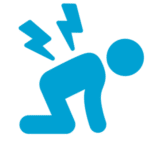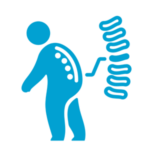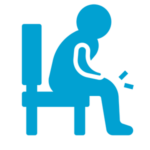Low Back Pain
Low back pain and stiffness are very most common conditions and surgery is typically not required. So what causes them, what are some of the mainstay non-surgical treatments and when should one see a doctor or a spine specialist?
Why is low back pain so common?
The bottom part of the back typically has just five vertebrae—fewer than the neck and mid-back. And these vertebrae do a lot of heavy lifting! The lower back is where your spine connects to your pelvis, bearing the weight of your entire upper body. As a pillar of one’s entire upper body, this area experiences a lot of movement and stress, which leads to wear, tear, and injuries.
What are common causes of low back pain?
Arthritis

Arthritis of the spine—the slow degeneration of the spinal joints—is the most common cause of low back pain. All of us experience wear and tear as we age, and it is normal for your low back to start acting up as one gets older. As the cartilage breaks down between the spinal joints, surrounding tissues may become inflamed. The inflammation and the thinning of cartilage increase friction in the joints, which may cause pain in the low back.
Back Injuries

A bad fall or a car accident can cause a lower back injury. But so can carrying a laundry basket up the stairs. Some back injuries can be sudden and traumatic, and some happen slowly overtime. One may think that athletes and active people get injured the most due to their active lifestyle. Believe it or not, it is just as likely to tweak the low back while bending over to pick up a sock from under the bed. It’s the everyday tasks, like holding a child, that may lead to back injuries when done improperly.
Herniated Discs

A herniated disc is a disc that has spilled out of its lining. The injured disc may not always hurt. But even if it’s painless, its contents can press on or irritate nearby nerves, causing pain in the lower back and other areas. Also, weakened disc can cause more stress on the spine, leading to faster wear and tear and arthritis.
Which lifestyle factors contribute to lower back pain?
There are three major lifestyle factors that may can increase the change of developing chronic low back pain:
Smoking can cause lower back pain. Smoking raises inflammation inside the body and weakens the joints and the discs by choking of blood supply and hinders the body from healing itself.
Obesity puts stress on the spine and accelerates the normal wear and tear process, leading to more low back pain.
Level of physical activity can lead to chronic low back pain. Too little exercise or sedentary lifestyle could increase your risk of developing lower back pain by weakening the core muscles that support the spine. Too much physical activity, especially if improper, can cause low backpain.
Can lower back pain be related to weather?
If you feel like your lower back pain worsens on days when it’s cold or the weather is changing, you are not imagining things. Back pain can indeed be related to barometric pressure and outdoor temperature. Changes in pressure can sometimes cause pain in arthritic joints, including the spine. Muscles and joints in general react to the environment, which can make them stiffer and more likely to suffer an injury.
Can lower back pain be kidney pain?
It absolutely can. Kidneys are located on the back side of your body and kidney pain can sometimes feel like back pain. The only true way to tell the difference is to visit a doctor who can conduct a thorough examination.
What does it mean if lower back pain is shooting into legs?
Lower back pain can radiate to other parts of the body: up or down from its place of origin. Sometimes low back pain can be on one side of the back, which is also normal.
If the pain is shooting from the lower back into one or both legs, it could be sciatica, but it’s not always the case. In fact, spinal joints, sacroiliac joints, and even inflamed muscles can cause back pain that extends into the leg.

Can lower back pain be a sign of something serious like cancer?
Its uncommon but low back pain can be related to cancer. In fact, any cancer can spread to the back and some, like sarcoma, can start in the back. Talk to your doctor if you have worsening back pain along with additional symptoms or concerns, such as significant unintended weight loss.
What can I do for low back pain at home?

If your lower back pain has just started, the best thing you can do is start a log. Record your symptoms, times, dates and which activities trigger the pain or make it worse or better. Take this information to your primary care physician if the pain doesn’t resolve on its own. It will make diagnosing the cause much easier.
Once you know which motion or position causes your lower back pain, try to avoid it and see if you get better. Icing the painful spot can also help. And so can over-the-counter pain relievers that help reduce inflammation. Just remember that pain killers treat only the symptom—pain—and not its cause.
When should I see a doctor if I have lower back pain?
In many cases lower back pain stops on its own. But if it doesn’t, here are some guidelines on when you may want to start seeking professional help:
- If the pain lasts four weeks or longer
- If the pain keeps getting worse as time goes by
- If you are experiencing other symptoms, such as fever, major weight loss or weight gain, loss of function or weakness in extremities, bladder problems, etc.
Who should I see for lower back pain?

Your primary care physician knows you best and should be your first contact for lower back pain. If he or she is unable to diagnose or treat the issue, you may get referred to a spine specialist. You may also get referred to a physical therapist, a chiropractor or another provider depending on the nature of your back pain. The good news is that surgery is rarely needed for lower back pain and most cases are well managed with non-operative treatments.
